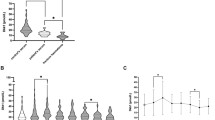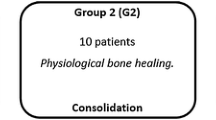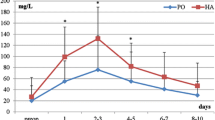Abstract
Fracture healing is an ordered process that restores the structural integrity of the bone. Soluble receptor activator of nuclear factor-kB (sRANK), its ligand (sRANKL) and osteoprotegerin (OPG) are involved in bone remodelling, thus they may play a role in fracture repair. OPG, soluble RANK and RANKL levels were measured in plasma and in drainage fluid, collected from pre-surgery phase to healing in ten patients of both genders (age range 26–65 years) with proximal humerus fracture needing osteosynthesis. All patients showed fracture healing. No significant modifications in the concentrations of sRANKL and OPG were observed, while sRANK showed a significant increase in drainage fluid 24 hours post-surgery compared with intra-surgery time. OPG levels were higher in plasma and drainage fluid than sRANK and sRANKL at each time point. Since there are no published data about sRANK involvement in fracture healing, our study represents the first preliminary indication about a local increase of this marker concentration immediately after surgery.




Similar content being viewed by others
References
Court-Brown CM, Garg A, McQueen MM (2001) The epidemiology of proximal humeral fractures. Acta Orthop Scand 72:365–371
Palvanen M, Kannus P, Parkkari J et al (2000) The injury mechanisms of osteoporotic upper extremity fractures among older adults: a controlled study of 287 consecutive patients and their 108 controls. Osteoporos Int 11:822–831
Burkhead WZ, Schienberg RR, Box G (1992) Surgical anatomy of the axillary nerve. J Shoulder Elbow Surg 1:31–36
DeFranco MJ, Brems JJ, Williams GR Jr et al (2006) Evaluation and management of valgus impacted four-part proximal humerus fractures. Clin Orthop Relat Res 442:109–114
Kong YY, Boyle WJ, Penninger JM (2000) Osteoprotegerin ligand: a regulator of immune responses and bone physiology. Immunol Today 21:495–502
Theoleyre S, Wittrant Y, Tat SK et al (2004) The molecular triad OPG/RANK/RANKL: involvement in the orchestration of pathophysiological bone remodelling. Cytokine Growth Factor Rev 15:457–475
Kearns AE, Khosla S, Kostenuik PJ (2008) Receptor activator of nuclear factor kappaB ligand and osteoprotegerin regulation of bone remodeling in health and disease. Endocr Rev 29:155–192
Boyce BF, Xing L (2008) Functions of RANKL/RANK/OPG in bone modeling and remodeling. Arch Biochem Biophys 473:139–146
Hofbauer LC, Schoppet M (2001) Serum measurement of osteoprotegerin-clinical relevance and potential applications. Eur J Endocrinol 145:681–683
Rogers A, Eastell R (2005) Circulating osteoprotegerin and receptor activator for nuclear factor kappaB ligand: clinical utility in metabolic bone disease assessment. J Clin Endocrinol Metab 90:6323–6331
Kon T, Cho TJ, Aizawa T et al (2001) Expression of osteoprotegerin, receptor activator of NF-kappaB ligand (osteoprotegerin ligand) and related proinflammatory cytokines during fracture healing. J Bone Miner Res 16:1004–1014
Gardner MJ, Griffith MH, Dines JS et al (2004) A minimally invasive approach for plate fixation of the proximal humerus. Bull Hosp Jt Dis 62:18–23
Kudlacek S, Schneider B, Woloszczuk W et al (2003) Serum levels of osteoprotegerin increase with age in a healthy adult population. Bone 32:681–686
Marchelli D, Piodi LP, Corradini C et al (2009) Increased serum OPG in atrophic nonunion shaft fractures. J Orthop Traumatol 10:55–58
Lee JS, Ryu CH, Moon NH et al (2009) Changes in serum levels of receptor activator of nuclear factor-kappaB ligand, osteoprotegerin, IL-6 and TNF-alpha in patients with a concomitant head injury and fracture. Arch Orthop Trauma Surg 129:711–718
Tan KB, Harrop J, Reddy M et al (1997) Characterization of a novel TNF-like ligand and recently described TNF ligand and TNF receptor superfamily genes and their constitutive and inducible expression in hematopoietic and non-hematopoietic cells. Gene 204:35–46
Yun TJ, Chaudhary PM, Shu GL et al (1998) OPG/FDCR-1, a TNF receptor family member, is expressed in lymphoid cells and is up-regulated by ligating CD40. J Immunol 161:6113–6121
Malyankar UM, Scatena M, Suchland KL et al (2000) Osteoprotegerin is an alpha vbeta 3-induced, NF-kappa B-dependent survival factor for endothelial cells. J Biol Chem 275:20959–20962
Hofbauer LC, Heufelder AE (2000) The role of receptor activator of nuclear factor-kB ligand and osteoprotegerin in the pathogenesis and treatment of metabolic bone diseases. J Clin Endocrinol Metab 85:2355–2363
Acknowledgements
The authors would like to thank Prof. Giuseppe Banfi for editing the manuscript and Dott. Cristian Ricci for help in statistical analysis of the data.
Author information
Authors and Affiliations
Corresponding author
Additional information
Alessandra Colombini and Giovanni Lombardi contributed equally.
Rights and permissions
About this article
Cite this article
Colombini, A., Lombardi, G., Galliera, E. et al. Plasma and drainage fluid levels of soluble receptor activator of nuclear factor-kB (sRANK), soluble receptor activator of nuclear factor-kB ligand (sRANKL) and osteoprotegerin (OPG) during proximal humerus fracture healing. International Orthopaedics (SICOT) 35, 777–782 (2011). https://doi.org/10.1007/s00264-010-1088-3
Received:
Revised:
Accepted:
Published:
Issue Date:
DOI: https://doi.org/10.1007/s00264-010-1088-3




